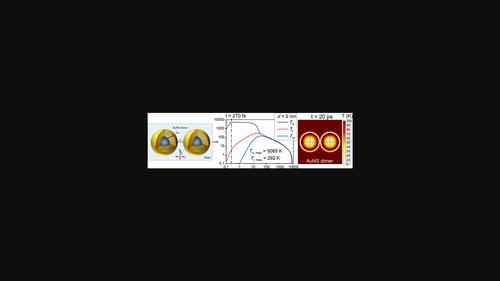当前位置:
X-MOL 学术
›
Int. J. Numer. Method. Biomed. Eng.
›
论文详情
Our official English website, www.x-mol.net, welcomes your feedback! (Note: you will need to create a separate account there.)
Thermal dynamics of gold nanoshell dimers under femtosecond laser pulse irradiation: A numerical approach
International Journal for Numerical Methods in Biomedical Engineering ( IF 2.1 ) Pub Date : 2023-09-18 , DOI: 10.1002/cnm.3773 Joshua Fernandes 1 , Sangmo Kang 1
International Journal for Numerical Methods in Biomedical Engineering ( IF 2.1 ) Pub Date : 2023-09-18 , DOI: 10.1002/cnm.3773 Joshua Fernandes 1 , Sangmo Kang 1
Affiliation

|
We present a numerical investigation of the photothermal response of gold nanoshell (AuNS) dimers when subjected to femtosecond laser pulse irradiation. The time-varying temperature fields for core–shell AuNS dimers are quantified by implementing finite element modeling, integrating the electromagnetic and thermal dual-physics simulations. Given the ultrafast nature of laser pulses, we employ a two-temperature model to accurately portray the energy transfer from excited electrons to the lattice system, a process typically completed post pulse-termination. The temporal analysis of the temperature in the AuNS and the surrounding medium, together with the spatial temperature distribution under different separation distances, elucidates the processes that drive the AuNS dimers' transient temperature distribution and heat dissipation. We report on the critical effects of geometrical parameters on the photothermal response, demonstrating that thinner shells maximize the total deposited energy per unit volume, resulting in increased temperature fields, while decreasing separation distances result in excessive field amplification due to plasmonic modes' production. Our robust numerical approach, enabling simulations with tunable material properties and configurations, may help design nanomaterials with desired features for photothermal cancer treatment and imaging.
中文翻译:

飞秒激光脉冲照射下金纳米壳二聚体的热动力学:一种数值方法
我们对金纳米壳(AuNS)二聚体在飞秒激光脉冲照射下的光热响应进行了数值研究。通过实施有限元建模、集成电磁和热双物理模拟,对核壳 AuNS 二聚体随时间变化的温度场进行量化。鉴于激光脉冲的超快性质,我们采用双温度模型来准确描绘从受激电子到晶格系统的能量转移,该过程通常在脉冲终止后完成。对 AuNS 和周围介质的温度的时间分析,以及不同分离距离下的空间温度分布,阐明了驱动 AuNS 二聚体瞬态温度分布和散热的过程。我们报告了几何参数对光热响应的关键影响,证明较薄的壳使每单位体积的总沉积能量最大化,从而导致温度场增加,而减小间隔距离则由于等离子体模式的产生而导致场过度放大。我们强大的数值方法可以通过可调的材料特性和配置进行模拟,可能有助于设计具有光热癌症治疗和成像所需功能的纳米材料。
更新日期:2023-09-18
中文翻译:

飞秒激光脉冲照射下金纳米壳二聚体的热动力学:一种数值方法
我们对金纳米壳(AuNS)二聚体在飞秒激光脉冲照射下的光热响应进行了数值研究。通过实施有限元建模、集成电磁和热双物理模拟,对核壳 AuNS 二聚体随时间变化的温度场进行量化。鉴于激光脉冲的超快性质,我们采用双温度模型来准确描绘从受激电子到晶格系统的能量转移,该过程通常在脉冲终止后完成。对 AuNS 和周围介质的温度的时间分析,以及不同分离距离下的空间温度分布,阐明了驱动 AuNS 二聚体瞬态温度分布和散热的过程。我们报告了几何参数对光热响应的关键影响,证明较薄的壳使每单位体积的总沉积能量最大化,从而导致温度场增加,而减小间隔距离则由于等离子体模式的产生而导致场过度放大。我们强大的数值方法可以通过可调的材料特性和配置进行模拟,可能有助于设计具有光热癌症治疗和成像所需功能的纳米材料。



























 京公网安备 11010802027423号
京公网安备 11010802027423号